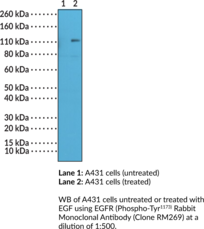Territorial Availability: Available through Bertin Technologies only in France
- Correlated keywords
- Erb-B1 ErbB-1 2 ErbB2 Tyr-1173 1148 1086 992 HER-1 2 3 4 RM-269 Erb-B2 Receptor Tyrosine Kinase 1
- Product Overview:
Epidermal growth factor receptor (EGFR), also known as HER1 and ERBB1, is a cell surface receptor and member of the EGF family of receptor tyrosine kinases with roles in cell proliferation, differentiation, and survival.{54146,54144} It is a transmembrane receptor composed of an intracellular tyrosine kinase domain, a transmembrane lipophilic segment, and an extracellular domain that is expressed in epithelial, mesenchymal, and neuronal tissues.{54146,54144,54147} Under unstimulated conditions, EGFR is an auto-inhibited monomer in the plasma membrane.{54146} Upon canonical ligand binding, EGFR undergoes homodimerization or heterodimerization with HER2, HER3, or HER4, which induces a conformational change in the cytoplasmic domain that facilitates autophosphorylation and intracellular signaling. EGFR contains five C-terminal autophosphorylation sites, tyrosine 1068 (Tyr1068), Tyr1148, Tyr1173, Tyr1086, and Tyr992.{60064} EGFR autophosphorylation at Tyr1173 (phospho-Tyr1173) leads to interaction with phospholipase C? (PLC?) and Shc, which have roles in activating the MAPK signaling pathway. Increased levels of EGFR (phospho-Tyr1173) are associated with poor progression-free survival in patients with non-small cell lung cancer (NSCLC). Levels of EGFR (phospho-Tyr1173) are increased in, and positively correlate with activation of MAPK signaling and cytokine production in, bronchial epithelial biopsies from healthy individuals exposed to diesel exhaust.{60065} Cayman’s EGFR (Phospho-Tyr1173) Rabbit Monoclonal Antibody can be used for immunohistochemistry (IHC) and Western blot (WB) applications.
Cayman Chemical’s mission is to help make research possible by supplying scientists worldwide with the basic research tools necessary for advancing human and animal health. Our utmost commitment to healthcare researchers is to offer the highest quality products with an affordable pricing policy.
Our scientists are experts in the synthesis, purification, and characterization of biochemicals ranging from small drug-like heterocycles to complex biolipids, fatty acids, and many others. We are also highly skilled in all aspects of assay and antibody development, protein expression, crystallization, and structure determination.
Over the past thirty years, Cayman developed a deep knowledge base in lipid biochemistry, including research involving the arachidonic acid cascade, inositol phosphates, and cannabinoids. This knowledge enabled the production of reagents of exceptional quality for cancer, oxidative injury, epigenetics, neuroscience, inflammation, metabolism, and many additional lines of research.
Our organic and analytical chemists specialize in the rapid development of manufacturing processes and analytical methods to carry out clinical and commercial GMP-API production. Pre-clinical drug discovery efforts are currently underway in the areas of bone restoration and repair, muscular dystrophy, oncology, and inflammation. A separate group of Ph.D.-level scientists are dedicated to offering Hit-to-Lead Discovery and Profiling Services for epigenetic targets. Our knowledgeable chemists can be contracted to perform complete sample analysis for analytes measured by the majority of our assays. We also offer a wide range of analytical services using LC-MS/MS, HPLC, GC, and many other techniques.
Accreditations
ISO/IEC 17025:2005
ISO Guide 34:2009
Cayman is a leader in the field of emerging drugs of abuse, providing high-purity Schedule I-V Controlled Substances to federally-licensed laboratories and qualified academic research institutions for forensic analyses. We are certified by ACLASS Accreditation Services with dual accreditation to ISO/IEC 17025:2005 and ISO Guide 34:2009.





